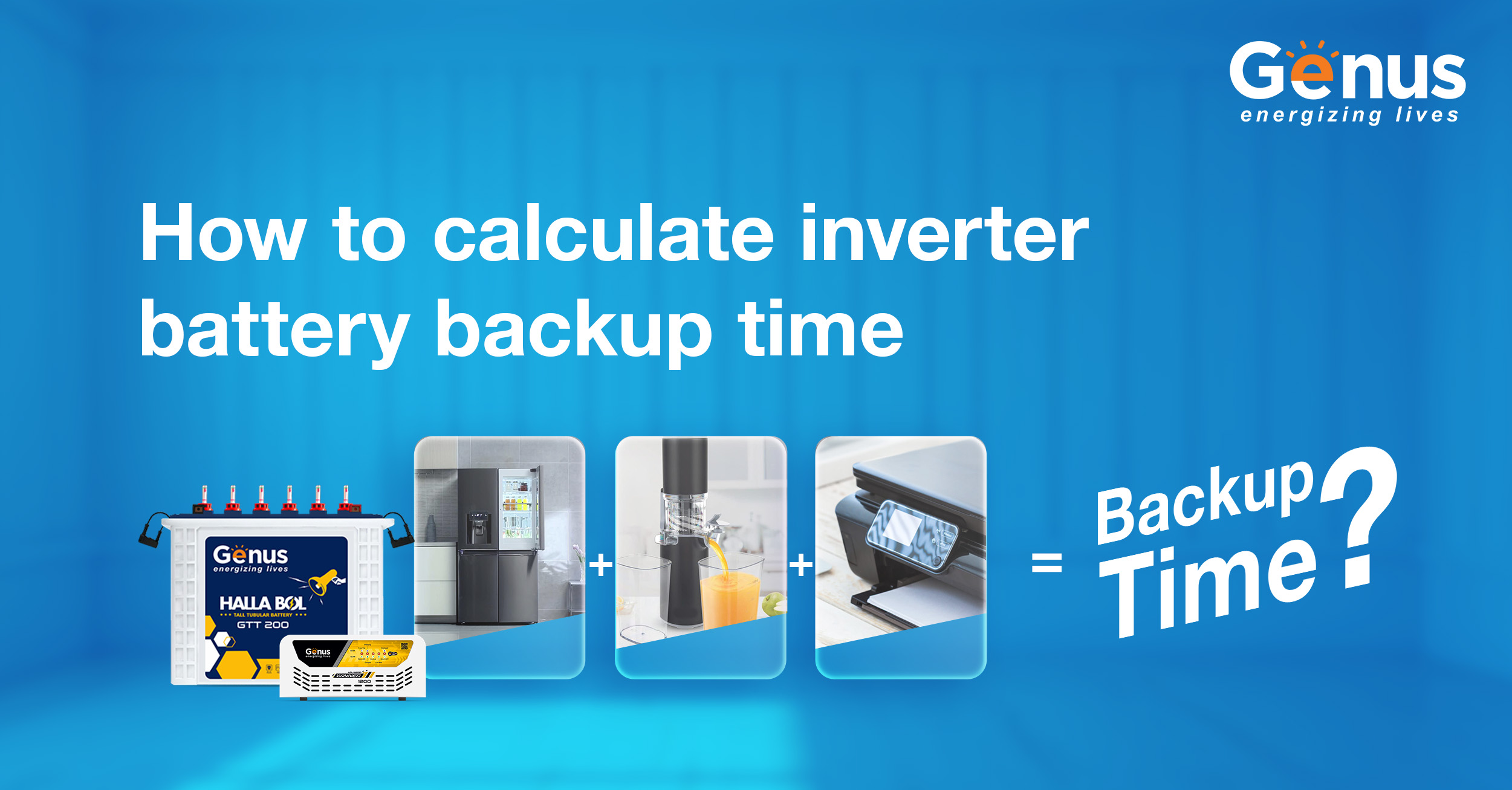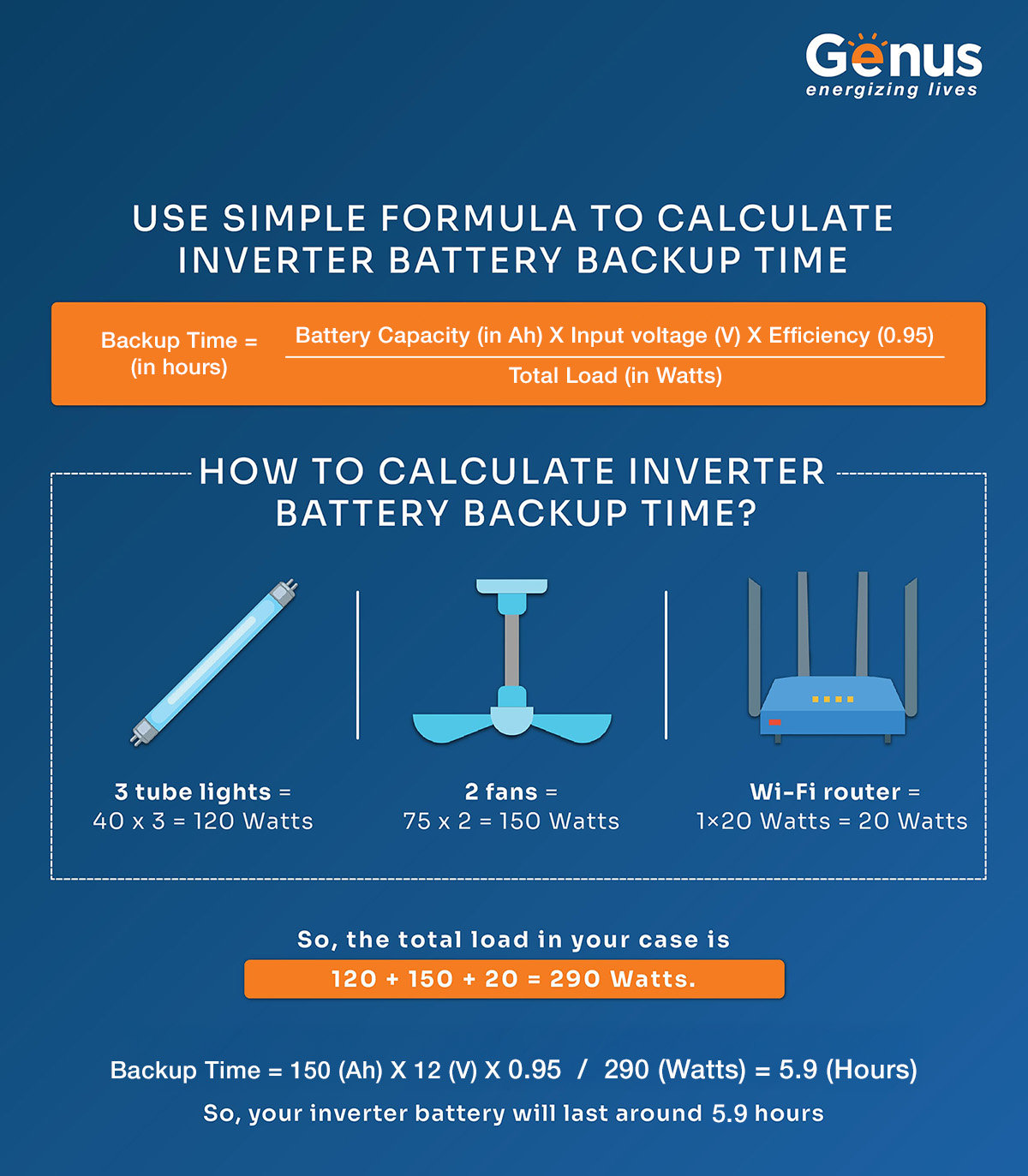
In today’s fast-paced world, an uninterrupted power supply has become necessary as several tasks heavily depend on it. However, power cuts are also becoming prevalent that pose major problems and hinder work. In this case, a reliable inverter battery system emerges as a savior to keep the work going. If you already have an inverter system in place then you must be aware of the many benefits that it offers. Some of you might also notice that the inverter battery is not able to last as long as it should. And, if you are looking to buy one, select the best inverter for your home and office that can provide the expected backup.
So now you know that battery backup time is the most crucial factor that determines which inverter can best match your requirements and provide the desired backup. However, most people rely on salespersons to determine this backup time instead of checking it on their own. The catch here is that with knowledge of some basic factors, you can calculate your inverter battery backup time on your own using a simple formula.
Today we are going to discuss the simple formula to calculate inverter battery backup time and also some useful tips to enhance battery backup efficiency so that it can last longer. In this blog, we’ll break it down for you in the simplest way possible. You’ll learn:
- What battery backup time means
- How to calculate it using a simple formula
- Tips to improve your inverter battery backup time
- Why choosing the right battery (like a lithium-ion inverter battery) makes all the difference
What is Battery backup time?
Battery backup time is the period for which an inverter can run the connected appliances during a power outage. There are 2 major factors on which it depends:
- The battery capacity (Ah)
- Power consumption of connected devices running on inverter during power cut
How to calculate the inverter battery backup time?
Inverter battery backup time could be calculated using this simple formula:
Backup time (in hours) = Battery capacity (Ah) * Input voltage (V) * Efficiency / Total load (W)
In this formula:
- Battery capacity is the Ampere hour rating of the battery (e.g. 150Ah, 200Ah)
- Battery voltage (which is usually 12V for a single Lead acid battery)
- Efficiency that is typically around 95% (0.95) for most of the inverters and
- Total load is the total wattage of appliances connected to the inverter
Let’s take a simple example to understand this:
Suppose the capacity of your inverter battery is 150Ah and you are using a single lead acid battery so the battery voltage or input voltage is 12V. You want to run 2 fans and 3 tube lights and 1 Wi-Fi router on the inverter. So in this specific case, the inverter battery backup time will be calculated as follows:

Total load:
3 tube lights = 40 * 3 =120 Watts
2 fans = 75 * 2 = 150 Watts
Wi-Fi Router = 20 * 1 = 20 Watt
Total load = 120 + 150 + 20 = 290 Watts
Now we will use the above-mentioned formula with all these values:
Backup time (in hours) = 150 * 12 * 0.95 / 290 = 5.9
So, in this example, the inverter battery can run the load of 2 fans and 3 tube lights and 1 Wi-Fi router for 5.9 hours.
Now, you know how to use the battery backup calculator so you can make the selection accordingly and get the inverter that can best match your power demands during an outage.
Why does knowing the inverter backup time matter?
At the time of selecting the best inverter battery for your home or best inverter battery for the office, knowing the backup time helps you:
- To avoid overloading the inverter during a power outage
- Choose the correct battery size
- Plan the appliances that you can use during a power cut
Also, you can enhance the life of the inverter battery as well by taking care of some simple factors. Now we will discuss things that can affect this backup time and ways to deal with them.
Factors that affect inverter battery backup time:
- The backup time is quickly reduced with the usage of high-power appliances such as microwaves, fridge etc.)
- Batteries that are poorly maintained or old may not provide a complete backup
- The type of inverter battery also plays a major role in backup time. Compared to traditional lead-acid batteries, lithium-ion inverter batteries usually last longer and charge faster too.
Tips to improve inverter battery backup time:
- Make use of energy-efficient appliances. You can choose things like energy-saving fans, LED lights etc.
- Switch to durable and reliable lithium-ion batteries that offer better performance as well
- Do not overload the inverter. You should take care of the load and avoid running several devices all at once
- The performance of the battery might be affected by corrosion and dirt so always keep the battery dry and clean
- Make sure to fully charge the battery since incomplete charging also shortens battery life
- In the case of lead-acid batteries, keep checking the water levels at regular intervals since low electrolyte levels can lead to problems
- Heat also reduces the efficiency of the battery so make sure to keep the inverter in a well-ventilated area
- Maintain regular servicing of your inverter by getting it checked by a technician
Also Read: Which is the Best UPS or Inverter for 2 BHK flat?
By taking care of these points, you can enhance the battery life and enjoy smooth and powerful performance.
If you are aware of how to calculate the inverter battery backup time then you can maintain it better and avoid the sudden interruptions of power. You can easily enjoy better performance and longer battery backup by selecting the right battery, running only the essential appliances, and following some of the important maintenance tips.
Make use of this battery backup calculator to take care of your inverter battery and in case you are looking to buy the best inverter battery for home, then consider modern and reliable options like lithium-ion batteries that are safe, smart, and long-lasting.
FAQs
How can I calculate inverter battery backup time?
You can use this formula for calculating inverter battery backup time:
Backup time (hrs) = Battery Capacity (Ah) x Voltage (V) x Efficiency / Load (W)
What is the inverter battery backup time?
It is the duration for which your inverter is able to power the connected appliances during a power cut, based on the total load and battery capacity.
Which factor affects the inverter battery backup time the most?
The major factors that affect the backup time of an inverter battery the most are health and capacity of the battery, appliance load, battery type and maintenance quality.
How can I increase my inverter battery backup?
It is possible to increase the inverter battery backup by avoiding overloading, using energy-efficient devices, switching to lithium-ion batteries and ensuring regular maintenance.
What makes it important to know the battery backup time?
If you are aware of your battery backup time, then it helps you to avoid overloading, ensures that the right battery size is selected and also allows you to plan the power usage during outages.
